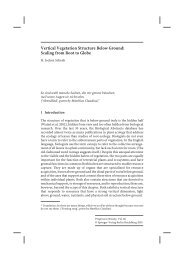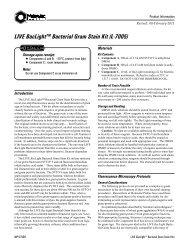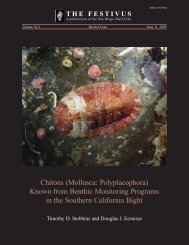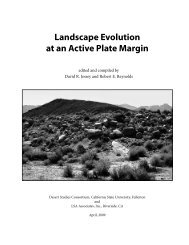2010 Overboard in the Mojave - Biological Science - California State ...
2010 Overboard in the Mojave - Biological Science - California State ...
2010 Overboard in the Mojave - Biological Science - California State ...
You also want an ePaper? Increase the reach of your titles
YUMPU automatically turns print PDFs into web optimized ePapers that Google loves.
. e. reynolds and d. m. mller<br />
56.5 (0.6) Cont<strong>in</strong>ue past Cherokee Road.<br />
60.0 (0.5) TURN RIGHT (west) on Golden Desert<br />
(power l<strong>in</strong>e) road.<br />
60.8 (0.8) The road bends.<br />
61.1 (0.3) The road bends; prepare for dips.<br />
61.7 (0.6) Cont<strong>in</strong>ue past deformed Lake Manix sediments.<br />
62.0 (0.3) BEAR RIGHT (north) between legs of double<br />
metal tower.<br />
62.1 (0.1) BEAR RIGHT on rutted dirt road head<strong>in</strong>g<br />
east-nor<strong>the</strong>ast toward m<strong>in</strong><strong>in</strong>g cuts on Harvard Hill.<br />
62.2 (0.1) Cross north over ruts <strong>in</strong> road and PARK near<br />
m<strong>in</strong><strong>in</strong>g cuts for stops Q-6 and M-1.<br />
62.7 (0.5) STOP Q-6—Harvard Hill M<strong>in</strong><strong>in</strong>g Cuts. A<br />
Stop Q-5. Wetterman Ranch Bluffs. Two red soil profiles Pleistocene thrust fault places Miocene limestone of <strong>the</strong><br />
developed on two sequences of lacustr<strong>in</strong>e silts and clays Barstow Formation over Pleistocene Lake Manix sedi-<br />
between lake fill<strong>in</strong>g events. M. Reheis photo.<br />
ments. Lake Manix sand, beach gravel, and m<strong>in</strong>or muds<br />
The white, f<strong>in</strong>e-gra<strong>in</strong>ed, water-laid Manix ash lies about are exposed <strong>in</strong> <strong>the</strong> pale badlands to <strong>the</strong> west. They repre-<br />
mid-section here. These exposures will be compared to sent folded sets of beach gravels <strong>in</strong>terbedded with sands.<br />
sediment recovered <strong>in</strong> a long core taken a few hundred These beds at <strong>the</strong>ir highest po<strong>in</strong>t lie at least 50 m above<br />
meters to <strong>the</strong> north. RETRACE to Vortac and Manix. <strong>the</strong>ir orig<strong>in</strong>al level, represent<strong>in</strong>g significant uplift <strong>in</strong> <strong>the</strong><br />
late Pleistocene and Holocene. Strands of <strong>the</strong> Manix fault<br />
50.7 (1.1) BEAR RIGHT (northwest) toward Vortac.<br />
lie to <strong>the</strong> north and south of <strong>the</strong> outcrops, and probably<br />
51.0 (0.3) Cont<strong>in</strong>ue past Vortac.<br />
<strong>in</strong>tersect with <strong>the</strong> Dolores Lake fault on <strong>the</strong> west to cause<br />
local compression. The thrust fault over <strong>the</strong> lake beds<br />
51.3 (0.3) Slow through curves.<br />
probably represents a more impressive manifestation of<br />
52.4 (1.1) Slow through curves.<br />
this same compression.<br />
52.8 (0.4) Cross railroad tracks and stop at Yermo Road. STOP M-1—South Harvard Hill stratigraphy and<br />
TURN LEFT (west).<br />
structure. WALK SOUTH to <strong>the</strong> contact between a high<br />
54.6 (1.8) Cont<strong>in</strong>ue past <strong>the</strong> sou<strong>the</strong>rn ridge of Lime<br />
ridge of silicified limestone and <strong>the</strong> sands that lie to <strong>the</strong><br />
Hill. Note <strong>the</strong> sou<strong>the</strong>ast-dipp<strong>in</strong>g Pliocene gravels (Byers,<br />
southwest of that ridge, <strong>the</strong>n proceed upsection across<br />
1960).<br />
<strong>the</strong> ridge, across ano<strong>the</strong>r ridge, and to <strong>the</strong> dark hill on <strong>the</strong><br />
nor<strong>the</strong>ast.<br />
55.0 (0.4) Cont<strong>in</strong>ue past a ridge supported by <strong>in</strong>durated<br />
round-cobble conglomerate (CRC, Reynolds and o<strong>the</strong>rs,<br />
Key observations here are <strong>the</strong> fac<strong>in</strong>g directions (north-<br />
this volume).<br />
east) for Miocene sediments, <strong>the</strong> ~19.1 Ma age of <strong>the</strong><br />
white tuff underly<strong>in</strong>g avalanche breccia, and correlation<br />
56.0 (1.0) TURN LEFT (south) at Harvard Road.<br />
of <strong>the</strong> limestone. Leslie and o<strong>the</strong>rs (this volume) argue<br />
that a thrust fault must lie <strong>in</strong><br />
this section because of older<br />
Miocene sediment ly<strong>in</strong>g on<br />
younger massive Miocene<br />
limestone that elsewhere lies on<br />
a 18.7 Ma tuff (Stop M-2). The<br />
coarse conglomerate and avalanche<br />
breccia <strong>in</strong> <strong>the</strong> Barstow<br />
Formation here <strong>in</strong>dicate prox-<br />
Stop Q-6. South Harvard Hill. Branches of <strong>the</strong> Manix Fault thrust Miocene sediments of<br />
imity to a steep bas<strong>in</strong> marg<strong>in</strong> to<br />
<strong>the</strong> Barstow Formation over late Pleistocene Manix Lake sediments.<br />
10 <strong>2010</strong> Desert Symposium
















